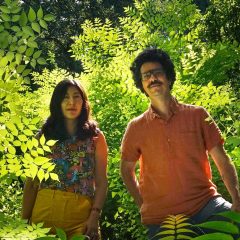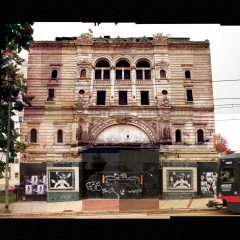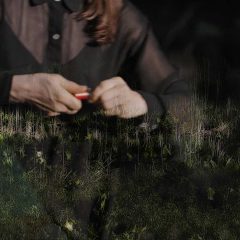Historic house museums all face considerable challenges. On the practical level, their fund-raising depends upon visitor numbers and these days there’s a lot of competition for visitors’ leisure time. Furthermore, historic houses have been premised on the idea of stepping back to a particular moment in time, an idea that has made historians increasingly uncomfortable. Heritage properties have often portrayed simplified and sanitized histories that mislead as much as educate. Since 2006 the Philadelphia Society for the Preservation of Landmarks has engaged artists both to attract new audiences for changing art installations and to offer more complex interpretations of its sites. Two recent projects made entirely different use of the Colonial-era Powell House.
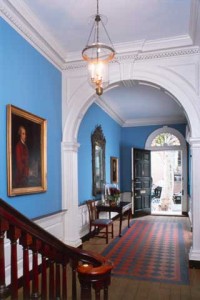
Paloma and Raul in San Serriffe by filmmaker J. Makary, on view in March, used the site to connote wealth and historical interiors, rather than invoking its own particular history. Her short narrative, itself set in the fictional San Serife (which was a famous April Fool’s day hoax of a London newspaper) was a domestic intrigue with dancers carrying on an abstract pantomime of the emotional goings-on. It had something of the look of a 1960s French film and the eavesdropping it showed was carried out with appropriately-dated technology of reel-to-reel tape. The eighteenth-century rooms implied a location, and perhaps a social class, that is conscious of its heritage. The clear artifice of the dancers emphasized the film’s fiction, and perhaps the fictionality of all narratives.
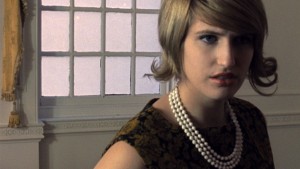
The protagonist Paloma was played with icy hauteur by Guin Buchan, and the original music by Michael McDermott contributed considerably to the atmosphere. Paloma and Raul in San Serriffe was shot on 16mm film. Makary has been working at the intersection of dance and film since 2006 when her first film was shown at the American Dance Festival in Durham, NC.
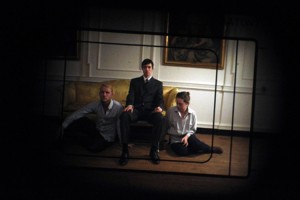
Post-Revolutionary Selections from the Powel House Moving Image Archive, 1888-2089, by Nadia Hironaka and Matthew Suib consists of four videos sited throughout the rooms of the Powell House. The title of the suite implies a non-existent archive and the four selections take place variously in the past and future. They emphasize the house’s changing history and fortunes, from an18th century home of Philadelphia’s mayor who entertained George Washington to a 20th century warehouse, and hence the fact that history always includes change. They also manage to re-insert some of the dirt, disorder and even stench that is ever part of life, but notably eliminated in historic house museum’s versions of history.
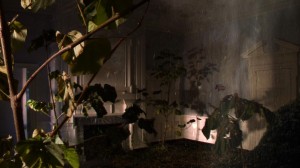
Powel House Garden Scene, its title a variation on the oldest surviving film, Louis Le Prince’s Roundhay Garden Scene (1888 and hence the date of Hironaka and Suib’s title), is set in an unspecified future when nature has taken over the current rooms. As if in the Biblical dust-to-dust the plaster crumbles and vines grow through the house, all shown as in a slow-motion nature film. From flora to fauna, A Pigeon’s History of America is the delightful fantasy of the house as a pigeon roost, adorned with their increasing droppings. The notes on the work carry the reassurance that no animals were harmed nor damage done to actual historic property; for this meditation on historical fictions we are reassured that these are, indeed, visual fictions.
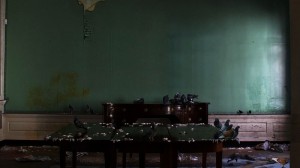
Minuet (Room On Room Action) is sited in the ballroom and was inspired by the room’s in-authenticity. The original interior was moved to the Philadelphia Museum of Art before the house functioned as an historic site, so what visitors to the house see is a re-creation. The video switches between original and copy then turns into an ecstatic whirl in which all reality is blurred and finally disappears. Hippy Party is another sly use of modern video illusion: actual clips of 1960s radicals talking about revolution appear to be taking place in the Powell House where 18th-century revolutionaries may well have had actual conversations. We’ve forgotten that those 18th century Americans may well have sounded like this to the British. Gerry Rubin is certainly wearing authentic, period tie-die; if he’s lucky, he saved it.
Post-Revolutionary Selections is on view through May 9, and on Saturday, May 8th at 2pm poets Thomas Devaney and Sparrow will present a performance piece, Tom Paine’s Pigeons, which promises to address the ongoing rhetoric of revolution in America.
All the artists’ projects are under the umbrella of Landmarks Contemporary Projects, directed and curated by Robert Wuilfe.


